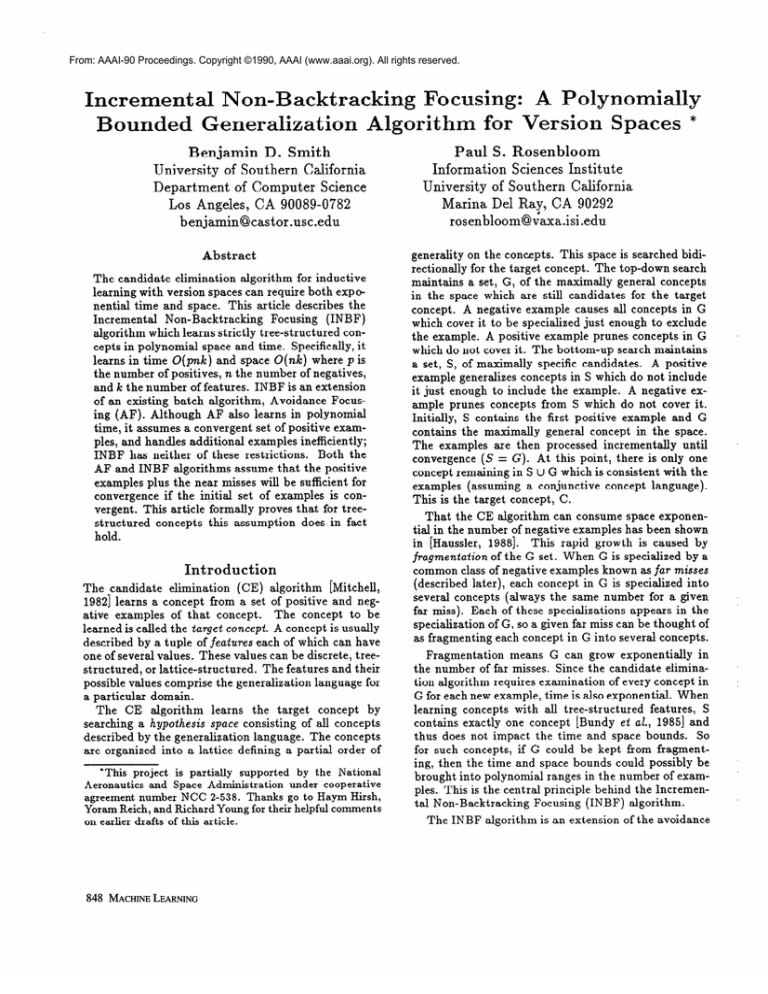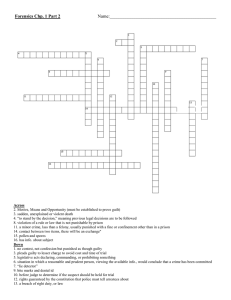
From: AAAI-90 Proceedings. Copyright ©1990, AAAI (www.aaai.org). All rights reserved.
Incremental Non-Backtracking
Focusing: A Polynomially
Bounded Generalization
Algorithm for Version
Benjamin D. Smith
University of Southern California
Department of Computer Science
Los Angeles, CA 90089-0782
benjamin@castor.usc.edu
Abstract
The candidate elimination algorithm for inductive
learning with version spaces can require both exponential time and space. This article describes the
Incremental
Non-Backtracking
Focusing (INBF)
algorithm which learns strictly tree-structured concepts in polynomial space and time. Specifically, it
learns in time O(pnrC) and space 0( nk) where p is
the number of positives, n the number of negatives,
and k the number of features. INBF is an extension
of an existing batch algorithm, Avoidance Focusing (AF). Although AF also learns in polynomial
time, it assumes a convergent set of positive examples, and handles additional examples inefficiently;
INBF has neither of these restrictions.
Both the
AF and INBF algorithms assume that the positive
examples plus the near misses will be sufficient for
convergence if the initial set of examples is convergent. This article formally proves that for treestructured concepts this assumption does in fact
hold.
Introduction
The candidate elimination
(CE) algorithm [Mitchell,
19821 learns a concept from a set of positive and negative examples of that concept.
The concept to be
learned is called the target concept. A concept is usually
described by a tuple of featzlres each of which can have
one of several values. These values can be discrete, treestructured, or lattice-structured.
The features and their
possible values comprise the generalization language for
a particular domain.
The CE algorithm
learns the target concept by
searching a hypothesis space consisting of all concepts
described by the generalization language. The concepts
are organized into a lattice defining a partial order of
*This project is partially supported by the National
Aeronautics and Space Administration under cooperative
agreement number NCC 2-538. Thanks go to Haym Hirsh,
Yoram Reich, and Richard Young for their helpful comments
on earlier drafts of this article.
848 MACHINE
LEARNING
Paul S. Rosenbloom
Information Sciences Institute
University of Southern California
Marina Del Ray, CA 90292
rosenbloom@&xa.isi.edu
generality on the concepts. This space is searched bidirectionally for the target concept. The top-down search
maintains a set, G, of the maximally general concepts
in the space which are still candidates for the target
concept. A negative example causes all concepts in G
which cover it to be specialized just enough to exclude
the example. A positive example prunes concepts in G
which do not cover it. The bottom-up search maintains
a set, S, of maximally specific candidates.
A positive
example generalizes concepts in S which do not include
it just enough to include the example. A negative example prunes concepts from S which do not cover it.
Initially, S contains the first positive example and G
contains the maximally general concept in the space.
The examples are then processed incrementally
until
convergence (S = G). At this point, there is only one
concept remaining in S U G which is consistent with the
examples (assuming a conjunctive concept language).
This is the target concept, C.
That the CE algorithm can consume space exponential in the number of negative examples has been shown
in [Haussler, 19881. This rapid growth is caused by
fragmentation of the G set. When G is specialized by a
common class of negative examples known as fur misses
(described later), each concept in G is specialized into
several concepts (always the same number for a given
far miss). Each of these specializations
appears in the
specialization of G, so a given far miss can be thought of
as fragmenting each concept in G into several concepts.
Fragmentation
means G can grow exponentially
in
the number of far misses. Since the candidate elimination algorithm requires examination of every concept in
G for each new example, time is also exponential. When
learning concepts with all tree-structured
features, S
contains exactly one concept [Bundy et al., 19851 and
thus does not impact the time and space bounds.
So
for such concepts, if G could be kept from fragmenting, then the time and space bounds could possibly be
brought into polynomial ranges in the number of examples. This is the central principle behind the Incremental Non-Backtracking
Focusing (INBF) algorithm.
The INBF algorithm
is an extension
of the avoidance
focusing (AF) algorithm [Bundy et al., 1985]. In general, focusing algorithms for tree- or lattice-structured
concepts [Young and Plotkin, 19771 bound the search
space with two concepts, upper and lower, instead of
with two sets, S and G. For a negative example, upper is specialized on one feature to exclude the value of
the example on that feature. If this feature’s value is
not included by the target concept, then this is a correct specialization, otherwise the specialization leads to
incorrect concept formation.
When the mistake is discovered, the focusing algorithm backtracks and selects
a different feature on which to specialize upper. Backtracking is focusing’s equivalent of fragmentation.
The AF algorithm [Young and Plotkin, 1977; Bundy
et at., 19851 is a batch algorithm that avoids backtracking by assuming that it has been given a convergent set
of examples, and processing all the positive examples
first so that lower is at the target concept, and then
processing just the near misses[Winston,
19751 to conThis assumes that
verge upper to the target concept.
the near misses will always be sufficient for convergence.
Converging upper to the target concept confirms that
the examples are consistent. A near miss is an example
for which only one feature is not covered by the target
concept.
Since lower is at the target concept, all the
near misses can be correctly identified along with the
feature that is not covered by the target concept. Since
this feature is known for each near miss, choosing this
feature always leads to a correct specialization,
and so
the AF algorithm never backtracks.
INBF uses a similar approach to avoid backtracking (fragmentation).
However, there are some inherent
drawbacks to the AF algorithm which INBF avoids. AF
assumes that there are enough positive examples for
lower to converge to the target concept.
If there are
insufficient positive examples, so that lower is below C,
then correct identification of all the near misses can not
be guaranteed. Furthermore, if more examples are presented later, they may generalize lower, in which case
the original negatives must be reprocessed since they
may now be identifiable as near misses. But because
AF is a batch algorithm, reprocessing the old negatives
is very inefficient, especially with many new example
sets. Lastly, many induction problems require an incremental algorithm, not a batch algorithm.
Though
AF could be rerun with the new examples, it would be
terribly inefficient, even when modified to save as much
work as possible from previous batches.
This article introduces the INBF algorithm, an incremental focusing algorithm which has tri-polynomial
space and time bounds in the number of positive examples, negative examples, and features. This algorithm
is limited to learning tree-structured
concepts’ in conjunctive languages.
Being incremental, additional ex‘Discussion with Richard Young leads us to believe that
INBF should be extensible to upper semi-lattices, as described in [Young and Plotkin, 19771.
amples are handled efficiently, and it uses less space
than its batch counterpart.
Unlike the AF algorithm,
the INBF algorithm (with extensions) can learn from
an incomplete
set of positive examples.
In this case,
the concept learned will be incomplete, but equivalent
to the one learned by the CE algorithm from the same
set of examples.
The rest of this article first describes the fragmentation problem, then explains the INBF algorithm and
how it avoids this problem.
This is followed by time
and space comparisons
of the INBF, AF, and CE alNext, it is, proven that the near misses
gorithms.
plus the positive examples are indeed sufficient for convergence if the entire set of examples is convergent,
as is required by both the AF and INBF algorithms.
Though several authors have suggested that this is the
case [Young and Plotkin,
1977; Bundy et al., 1985;
Hirsh, 19901, no formal proof appears in the literature.
Finally, an extension to INBF is suggested that handles
non-convergent
examples, and limitations of the INBF
algorithm are discussed.
Fragmentation
When G is specialized by a negative example, the specialization must cover the target concept but not the
negative example.
Only specializatons
of G made on
certain features, called guiZty features, will satisfy these
criterion. Specifically, guilty features are exactly those
features, f, for which feature f of the negative example
is not covered by feature f of the target concept. Fragmentation occurs because it is not generally possible
to distinguish the guilty features of a negative example
from the non-guilty features. At best, only some of the
non-guilty features can be identified. These are exhoneruted features.
The non-exhonerated
features include
all of the guilty features and some non-guilty features.
Since the
This is the set of possibZy guilty features.
CE algorithm can not accurately select a single guilty
feature from this set, it specializes G on uZZof the features in the set. Specializations
made from non-guilty
features will not cover the target concept and will eventually be pruned by positive examples. Only specializations made from the guilty features will remain. Each
possibly guilty feature makes its own specialization of
each concept in G. So if there are n possibly guilty features, then for every concept in G there are n concepts
in the specialization
of G. G has fragmented.
But why can’t the guilty features be distinguished
from the others? Guilty features are those features of a
negative example which are not covered by the target
concept. But the target concept is not known a priori,
so the guilty features can not always be distinguished
from the others. Some features, though, can be exhonerated as definitely not guilty. All concepts subsumed
by S are subsumed by the target concept, so if feature f of the negative example is subsumed by feature
f of a concept in S, then f can not be guilty. How-
SMITHANDROSENBLOOM
849
ever, some concepts subsumed by the target concept
are not subsumed by S, so some non-guilty features can
not be exhonerated. Since all of the non-guilty features
can not be exhonerated, the guilty features can not be
distinguished from the non-guilty features. The more
general S is, the more concepts it covers and the more
non-guilty features it can exhonerate.
When S reaches
the target concept, all of the non-guilty features can be
exhonerated.
The only kind of negative example guaranteed not
to fragment G is a near miss. These examples have
only one possibly guilty feature, so each concept in G
maps to only one concept in G’s specialization.
By contrast, a negative example with more than one possibly
guilty feature is called a fur miss. The more specific
S is, the few& non-guilty features it can exhonerate,
and the more features it must therefore label as possibly guilty. Thus a negative example which has several
possibly guilty features (a far miss) with respect to a
specific S may have only one possibly guilty feature (be
a near miss) with respect to a more general S. Since S
increases monotonically
in generality to the target concept, examples which are initially classifiable only as
far misses may later be identifiable as near misses. The
INBF algorithm relies on this phenomenon.
INBF()
lower= pl; upper = (ANY, . . . , ANY); wait-list=
LOOP until upper = lower OR collapse
{}
For a positive example, p
Generalize lower to include p
FOR each negative example, n, in wait-list Do
PROCESS-NEGATIVE(n)
For a negative example, n
IF n is not covered by (less than) upper
THEN
Discard n
ELSE
PROCESS-NEGATIVE(n)
PROCESS-NEGATIVE(n)
Compare n and lower to determine number of
possibly guilty features.
CASE (number of possibly guilty features) OF
guilty = 0 : collapse
guilty = 1 : Specialize upper on the single
guilty feature of n.
Remove n from wait-list.
guilty > 1 : Add n to wait-list if it’s
not already there.
Figure 1: Incremental
Non-Backtracking
Focusing
The Algorithm
The INBF algorithm is an incremental version of the
batch AF algorithm. Like the AF algorithm, the INBF
algorithm exploits the fact that upper is guaranteed to
converge without backtracking
to the target concept
when specialized only by all of the near misses from
a convergent set of examples. The key is guaranteeing
that all of the near misses can be recognized, and therefore used. But a near miss could possibly be classified
as a far miss if lower is more specific than C. The batch
algorithm guarantees identification of all near misses by
processing all of the positive examples first so that lower
is at C (assuming a convergent set of examples). Then
just the near miss negatives are processed, and the far
misses are discarded.
An incremental algorithm, however, can not expect
all the positive examples first, so lower is more specific than C during most of the learning.
Therefore
INBF can not simply discard far misses as does AF:
near misses that should be processed might be discarded because they were temporarily
misclassified as
far misses. Since these far misses may later be recognizable as near misses as lower converges to C, INBF
saves the far misses on a list until they can be recognized. Avery time lower is generalized, the list of saved
far misses is scanned for far misses which are now recognizable as near misses. These near misses are used to
specialize upper, and are then removed from the list.
Figure 1 presents the INBF algorithm. lower is initialized to the first positive example, p’; upper is initialized
to the maximally general concept,
(ANY, . . . , ANY);
850 MACHINELEARNING
and the list of saved negative examples, wait-list, is initialized to empty. If the algorithm receives a positive
example, lower is generalized to include it. Some far
misses may be recognizable as near misses by the new
lower, so wait-list
is scanned for near misses. upper is
specialized to exclude any newly discovered near misses,
and the near misses are removed from the list of saved
negatives. If after an example has been processed upper and lower are equal, then they have converged to
the target concept, and the algorithm has succeeded.
Otherwise, the next example is processed.
Negative
examples
are first compared
to upper.
Those not less than upper would be classified as negative
anyway, and are discarded. The CE algorithm performs
a similar test. Otherwise, the negative is compared to
lower to determine the number of possibly guilty features. If the example is guilty in zero features, then
the version space is inconsistent.
If the example is a
near miss then it specializes upper. If the example is
a far miss, then it is saved on wait-list until it can be
recognized as a neaS miss.
Time/Space
Summary
The INBF algorithm uses considerably
less time and
space than the CE algorithm in the worst case, and the
same amount in the best case. The worst case bounds
are derived as follows.
Let p be the number of positive examples, n the number of negatives, and k the
number of features. Each concept requires O(k) units
of storage (for k features). INBF maintains only three
upper and lower
variables: upper, lower, and wait-list.
are single concepts, and wait-list clearly has an upper
bound of n concepts. Thus the total space requirement
is O(k) + O(k) + O(nk) = O(nk). PROCESS-NEGATIVE
can be done in O(k) time if its argument, n, a negative example, can be added or deleted from wait-list in
constant time, and if the guilt of a feature of n can be
determined in constant time. The latter is possible if
examples are represented in vector notation, explained
in the next section. Additions can be done in constant
time by adding to the front of the list. For deletions,
INBF knows where n is in wait-list
at the time INBF
Cdk
PROCESS-NEGATIvE.
If we pass this pointer to
PROCESS-NEGATIVE
along with n, then n can be deleted
from wait-list in constant time. Each positive example
calls PROCESS-NEGATIVE
once for each example in waitlist. Each negative example makes a single call. Total
time is thus O(pnk) + O(nk) = O(pnk).
Derivation
of the other results appear in [Smith and Rosenbloom,
19901.
1
Worst Case Analysis
INBF
O(pnk)
0( nk)
Time
Space
AF
O(pk + nk)
O(pk + nk)
$km+‘)
O(kn”)
The AF algorithm
performs poorly on additional
batches. All the negatives seen so far must be reprocessed for each new batch in order to find near misses
not recognized in previous batches.
The following is
based on b batches of one positive and one negative
example each.
Worst Case Analysis:
Time
Space
Multiple
Batches
II INBF
I AF
1 CE
O(b2k)
O(b3k)
O(kb+‘)
O(kb+l)
O(bk)
w4
J
Best Case Analysis
Time
Space
AF
O(pk + nk)
O(pk + nk)
Near Miss Convergence
{e
{e
{e
{e
1e
1e
1e
1e
is
is
is
is
a
a
a
a
positive example}
far miss negative example}
near miss negative example}
negative example} = F U M
Theorem 1 (Near Miss Convergence
Theorem)
If a set of strictly tree-structured
examples P U F U M
of a concept is suficient for convewence
(G = S = C)
of the Candidate Elimination Algorithm, then PU M is
also suficient for convergence.
Vector Notation
Concepts and examples with tree-structured attributes
can be represented as vectors.
This notation is used
throughout the proof to simplify the arguments. Each
feature of a concept (or example) is a component of the
vector and is assigned an integer indicating its distance
from p’, the first positive example.
The distance between feature i of a concept and feature i of p1 is the
number of nodes that feature i of p1 must be moved
up in the feature tree to reach a value which subsumes
feature i of the concept.
For example, assume we have a concept with two features, each feature having the structure shown in Figure 2. If p’ = (d,e), then the vector for (b,b) would be
/
ANY
\
P
d
A
e
f
Figure 2: Feature Tree
The best case for all the algorithms occurs when all
the negative examples are near misses. For the INBF
algorithm, the list of saved negatives is always empty.
For the CE algorithm, G never fragments.
INBF
O(pk + nk)
O(k)
P =
F =
M=
N =
CE
O(pk + nk)
O(k)
Theorem
The Near Miss Convergence Theorem is the crucial result upon which both the INBF and AF algorithms rely.
That is, that the positive examples plus the near misses
alone are sufficient for convergence if the entire set of
examples (positives plus negatives) are convergent. The
theorem and proof are given formally below. The proof
relies on a vector notation which is explained first, followed immediately by the proof of the theorem.
(1,2). Feature i of vector p is denoted pi. For any given
tree-structured feature, i, the values that could be part
of the target concept must lie between pi and ANY. This
constrains the values to a single path from ANY to pt.
Thus, vector notation indicates, for a particular value,
where that value lies on the path. Values off of the path
are never part of the target concept, so each vector defines a unique concept. For example, if pt = e, then the
only possible values for Ci are e, c, and ANY. 0 refers to
e, 1 to c, and 2 to ANY.
If Ai 1 Bi then A subsumes B on feature i. If ViAi 1
.& then concept A subsumes concept B (A 2 B). Vectors form a partial order of generality, with smaller vectors being more specific than larger vectors.
Concept A can be generalized to include concept B
by setting each feature, i, of A to max(A;, B;). Then
V;A, 2 Bi, so A subsumes B. Furthermore A is the
maximally specific concept which does so. A can be
specialized to exclude B by causing A to not subsume
B on some feature, i. This is done by setting Ai to
B, - 1. Since B; - 1 is the smallest integer which fails to
subsume &, A is the maximally general concept which
SMITHANDROSENBLOOM
851
excludes B on feature i. Aside from notational simplicity, this method also makes specialization
and generalization very fast operations.
The usual tree searches
can be avoided altogether once a concept’s vector has
been established with respect to p’.
Definitions,
Lemmas,
and Observations
Definition 1 (Least Upper Bound
The Least Upper Bound of G, written
tor (uG1, uG2,. . . , uG~), where each
specific value for feature i s.t. tlgE G
of G: LIG)
uG, is the vecuG~ is the most
U Gi 2 gi.
Observation
1 For tree-structured
features, UG; can
also be defined as the least common parent of the set
of values taken by concepts in G on feature i. That is,
uG~ is the least common parent of the values in the set
bib E G) wh ere i is a tree structured feature.
Observation
2 Let V be a set of tree structured values. Let the least common parent of these values be
denoted UV (by Observation 1, the least common parent of V is also the least upper bound of V, hence the
notation).
Adding OT deleting a value, v, from V will
have no effect on UV as long as v is subsumed by some
UV is the least common
other value in V. Formally,
parent of the following sets of tree structured values: V,
V U (v), and V - (v) where v is subsumed by a value
in V.
Lemma 1 In an uncollapsed version space with strictly
tme-structured
attributes G = S ifi {uG) = S.
Lemma 2 If G’ is the set of concepts that result from
specializing a set of tree-structured
concepts, G, with a
consistent far miss negative example, then UG’ = UG.
Observation
3 If a set, G, contains
x, then UG = x.
Proof
of Theorem
only one element,
1
We must show that P u M yields G = S = C. Assume
that all the positive examples have been seen, and thus
that S = C. By Lemma 1 it is therefore sufficient to
show UG = C.
But by Lemma 2 we know that F
has no effect on UG, and thus whether or not G = C is
independent of F. Therefore since PUMUF is sufficient
for UG = C, so must be P U M. 0
Proof
of Lemma
1
(1) If G = S then {uG) = S
Assume that G = S and that the concepts in
sion space have only tree-structured
features.
sion spaces with such concepts, S has only one
[Bundy et al., 19851. Call this element s. G
assumption, so G = {s).
By Observation
3,
and thus (uG) = (s) = S.
the verFor verelement
= S by
UG = s
(2) If {uG) = S then G = S
Assume that {uG) = S, and that concepts in the version space have only tree-structured
features. Then G
852 MACHINELEARNING
has either one, or multiple elements (in a consistent version space, G can not have zero elements). Assume G
has multiple elements. By Definition 1, VgE G g 5 IJG.
and since the version
But {uG}
= S by assumption,
space only contains concepts with tree-structured
features, S has only one element, s. Thus Vg f G g 5 s.
But the version space collapses when every concept in
G is strictly less than some concept in S, so there must
be at least one element, g, of G that is equal to s. Since
s subsumes every concept in G, so does g. But G contains only concepts which are not subsumed by other
concepts in G, so G = 69). This violates our assumption that G has multiple elements. Therefore G must
have exactly one element. Call it t . Then by Observation 3, UG = Z; but {uG) = S by assumption, and
thus S = (uG3 = {z) = G. So G = S. 0
Proof
of Lemma
2
Let f be a consistent far miss, and G’ be the set of concepts that results from specializing G with f. G’ can
be constructed from G and f by the construction algo
rithm (Figure 3) in two stages. Call the sets formed in
these stages G1 and G2 respectively. The construction
algorithm is the vector-notation
equivalent of the action taken by the CE algorithm on a negative example.
G2 is then returned as G’. For each feature, i, let Vi
be the set of values for feature i held by concepts in G,
i.e., Vi = {g; jg E G). Similarly, I$’ = {gt lg’ E GL) and
V,’ = {gz]g2 E G2). We will show that for any feature,
the set of values for the feature held by the concepts in
each stage is formed by adding or deleting zero or more
values which are subsumed by values in the previous
stage. Thus by repeated application of Observation 2,
UK = lJv,l = UVi2. Then by Observation 1, UG; = UVi
and uG{ = uVi2. Thus uGi = UGI, and since this holds
for all i, UG = UG’.
First we show that for every feature, i, Vi1 = V; U Ei
where Ei is a set of values subsumed by values in Vi.
In stage one, G1 is initially empty. Every concept g
in G then adds one concept to G1 for every possibly
guilty feature of f. When a given concept g in G, is
specialized on a possibly guilty feature j, g adds one
concept to G1 with a value for feature j of m.in(gj, fj 1). When specialized on a possibly guilty feature k # j,
each g in G adds a concept to G1 with a value of gj for
feature j. So if there are at least two possibly guilty
(1) FOR
each possibly guilty feature, i, off
each concept g in G DO
E F DO
FOR
9’ = 9
gl = min(gi, fi - 1)
Add g’ to G’
(2)
. Remove from G’ every concept
another concept in G’.
Figure 3: Construction
subsumed
Algorithm
by
features, then for every feature i, the set of values, Vi’,
taken by the concepts in G1 on feature i is {g;lg E
G} U (min(g;,f;
- 1)/g E G) = Vi U Ei. If i is not a
possibly guilty feature, E; = {}.
We are guaranteed
at least two possibly guilty features since G is being
specialized by a far miss, f, and far misses always have
multiple possibly guilty features. Note that for every i,
min(gi, fi - 1) 5 g;, i-e, min(gi, fi - 1) is subsumed by
gi. Thus for every i, every value in Ei is subsumed by
some value in Vi, so by Observation 2, LIVE = uVil.
Next we show that q2 is vi1 - & where & is a set of
values subsumed by values in I<‘, and i is any feature.
In stage two, G2 is formed by removing from G1 all
concepts which are subsumed by another concept in G1.
Let the set of removed concepts be R. Thus Vi2 is Vi1
minus the set of values, & taken by concepts in R on
feature i. But every concept in R is subsumed by a
concept in G1, so every value in Ri is subsumed by
some value in Vi’. Therefore Vi2 = Vi1 - &, and fi is
subsumed by Vi’, so by Observation 2, LIVE’= uVi2. 0
Incompletely
Learned
Concepts
There are many learning domains in which the availability of examples is limited, or for which prohibitively
many examples are required for convergence.
In such
domains there are insufficient examples for convergence,
so the set of examples is non-convergent
and the target
concept is incompletely
learned.
However, we would
still like to classify new instances as being positive or
negative examples of the incompletely
learned target
concept. In the CE algorithm, examples subsumed by
S are always positive, those not subsumed by G are negative, and those between S and G can not be classified.
In the INBF algorithm,
examples below lower are
positive, and those not below upper are negative. But
there could be examples under upper which the CE algorithm would classify as negative. This is because not
all the near misses have been recognized and thus upper
bounds the target concept more loosely than does G.
Let G-final be the G set after the CE algorithm
has processed the (incomplete)
set of examples. INBF
can generate G-final from upper by processing all the
saved negatives the same way the CE algorithm does.
In the CE algorithm,
G converges on G-final nonmonotonically.
Negative examples cause G to increase
in size by fragmenting it, and positive examples reduce
Under many example orderG by pruning concepts.
ings, G can initially fragment beyond the size of G-final,
meaning that the size of G fluctuates as it approaches
G-final. By contrast, the size of the G set in the INBF
algorithm increases monotonically to the size of G-final.
This is because only the saved negative examples are being processed to specialize upper. A negative example
can only cause G to increase in size, so G must increase
monotonically
from one concept (upper) to several (Gfinal). Thus the maximum size attained by G for INBF
is usually less, and never greater, than the maximum
size of G for the CE algorithm.
The degree to which
the maximum sizes differ depends on the order of the
examples.
Since the space bound of both algorithms is proportional to the maximum size attained by G, INBF saves
space over the CE algorithm for most example orderings. For the remaining orderings, both algorithms have
equivalent space bounds. Since time is proportional to
space, these savings apply to the running time as well.
Conclusions
and Limitations
For strictly tree-structured
concepts, INBF is provably equivalent to the CE algorithm, but is polynomial rather than exponential.
Unlike the AF algorithm,
INBF can efficiently process additional examples, and
can deal with non-convergent
sets of examples and incompletely learned concepts.
For such sets, INBF has
the same worst-case time and space bounds as the CE
algorithm, but better best-case bounds.
The INBF algorithm is restricted to learning strictly
tree-structured
concepts
(and possibly upper semilattices). It is, at present, unable to learn concepts with
arbitrary lattice-structured
features. Lattice structured
features allow pairs of values to have more than one
least common parent. This means that there is more
than one way to generalize a concept to include a positive example, and thus S can fragment. It also means
that a near miss no longer specifies a unique specialization (generalization)
of G (S), and thus near misses can
not prevent fragmentation.
Learning lattice-structured
concepts is an area of future research.
References
(Bundy et al., 1985) A. Bundy, B. Silver, and D. Plummer. An analytical comparison of some rule-learning
programs. Artificial Intelligence, 27, 1985.
(Haussler, 1988) David Haussler.
Quantifying inductive bias: Artificial intelligence learning algorithms
Artificial Intelliand valiant’s learning framework.
gence, 36, 1988.
(Hirsh, 1990)
tion.
(Mitchell,
search.
Haym Hirsh, 1990.
Private communica-
1982) T om M. Mitchell.
Generalization
Artificial Intelligence,
18, 1982.
as
(Smith and Rosenbloom,
1990) B.D. Smith and P.S.
Rosenbloom.
Polynomially
bounded generalization
algorithms for version spaces. In preparation, 1990.
(Winston, 1975) P. Winston.
Learning structural descriptions from examples. In The PsychoEogy of Computer Vision. McGraw-Hill, New York, 1975.
(Young and Plotkin, 1977) Richard
M. Young
and
Gordon D. Plotkin. Analysis of an extended conceptlearning task. In IJCAI, 1977.
SMITHANDROSENBLOOM
853





